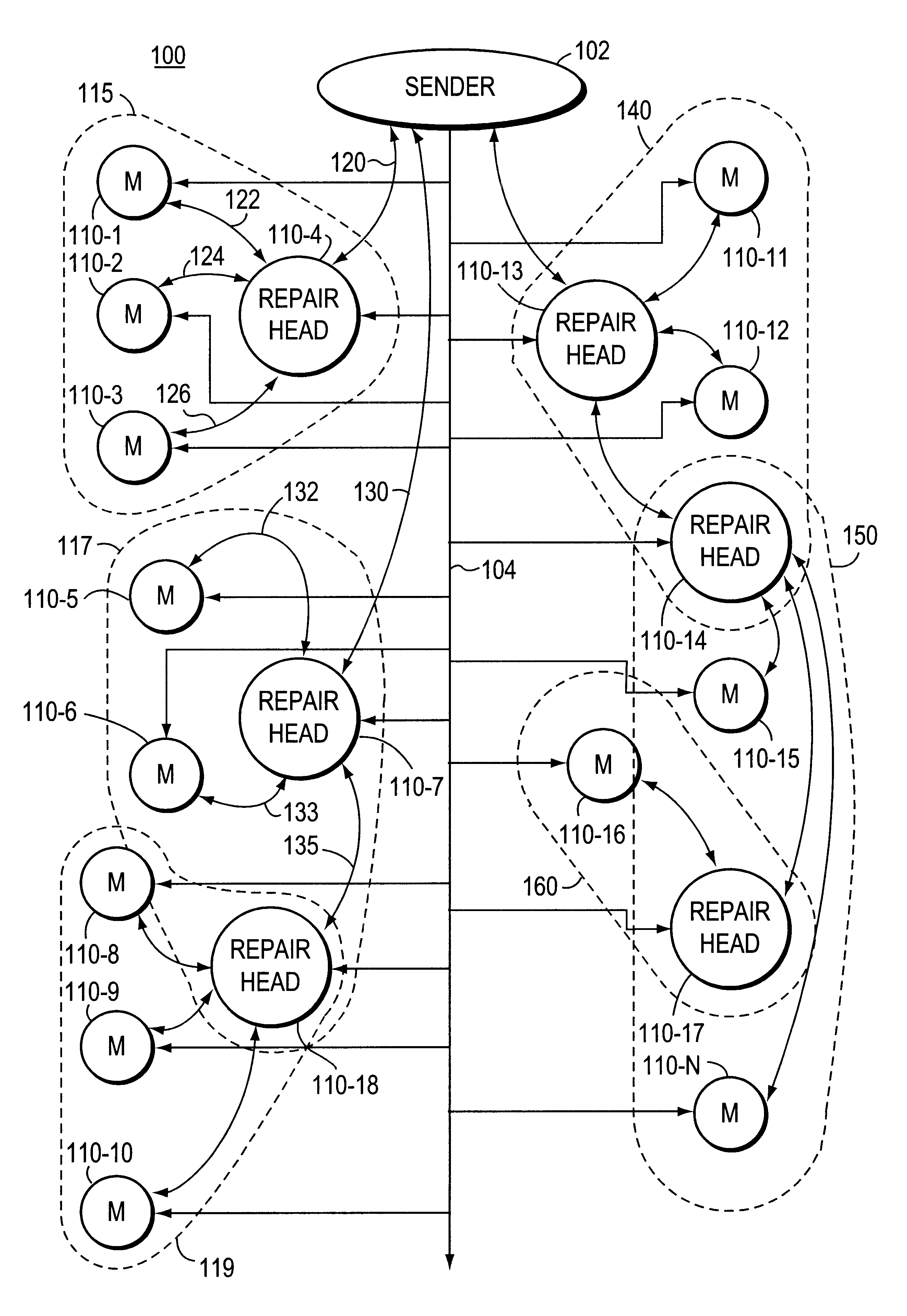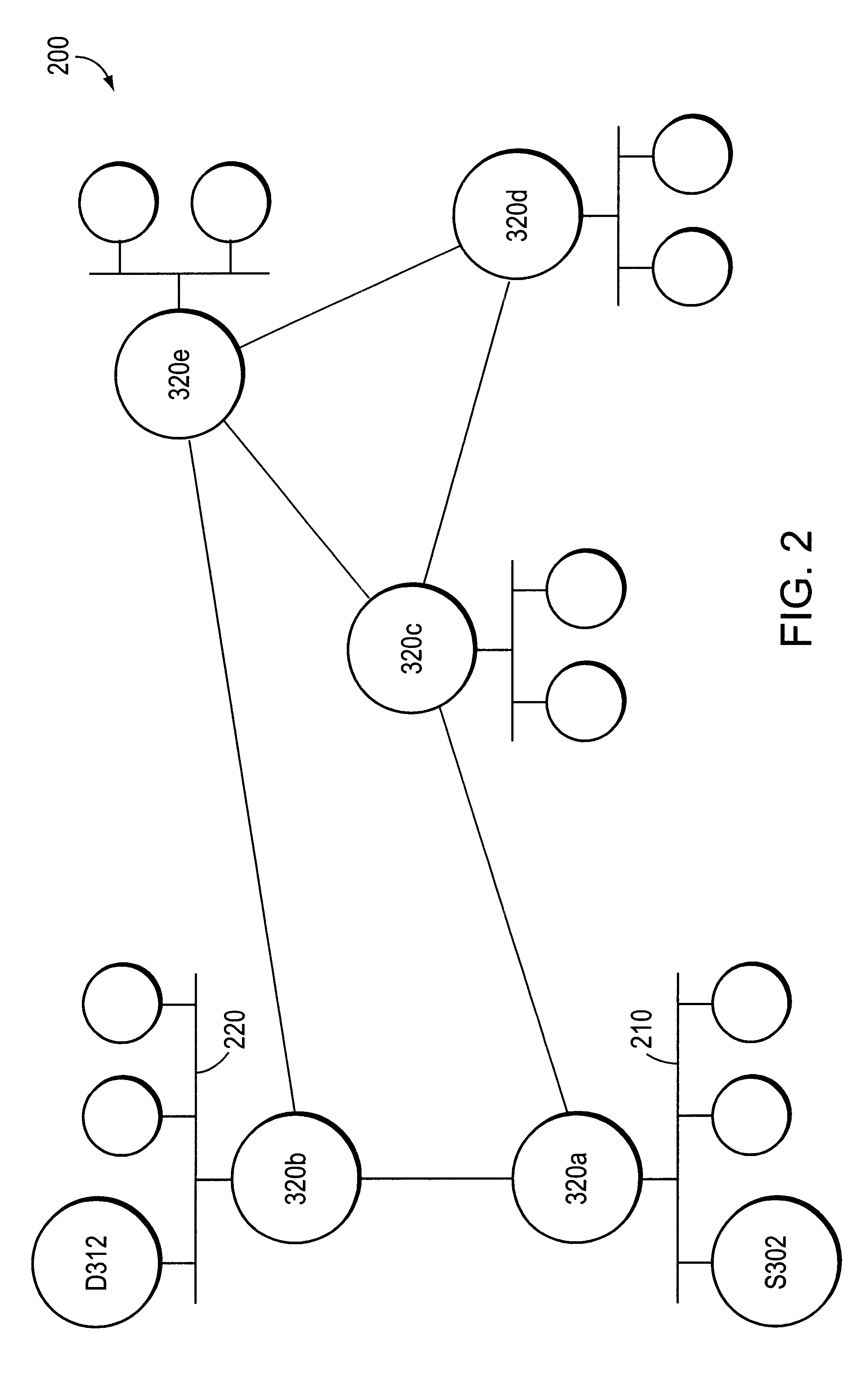Multiple ACK windows providing congestion control in reliable multicast protocol
a multicast protocol and congestion control technology, applied in the field of multicast communication, can solve the problems of large number of ack or nack messages overpowering the transmitting station, network, including intermediate nodes such as routers, etc., and achieve the effect of reducing the number of ack or nack messages
- Summary
- Abstract
- Description
- Claims
- Application Information
AI Technical Summary
Problems solved by technology
Method used
Image
Examples
first exemplary embodiment
Turning now to FIG. 1, there is shown a multicast repair tree 100. Sender station 102 is transmitting a multicast message to the other stations shown in FIG. 1. Communication path 104 represents the fact that sender station 102 transmits a message having a multicast address, and this message is received by all of the addressed stations, 110-1, 110-2, . . . 110-N directly from sender station 102. Communication path 104 may include, physically, many hops through many physical networks. Communication path 104 simply represents that the destination stations receive the multicast message directly from sender station 102.
Multicast repair tree 100 may be established as a static structure, by for example a person establishing the sender, head, and member status on each station. The person normally has "network manager" status, and uses a computer program to establish the tree 100 by configuring the various stations through setting status in each member station by use of management control m...
second exemplary embodiment
Communications
FIG. 2 is a schematic block diagram of a computer intemetwork 200 comprising a collection of interconnected communication media attached to a plurality of stations. The communication media may be configured as local area networks (LANs) 210 and 220, although other media configurations such as point-to-point network links may be advantageously employed. The stations are typically computers comprising source and destination end stations 302, 312, such as personal computers or workstations, and intermediate stations 320a-e such as routers, bridges, switches and / or firewalls. Communication among the stations is typically effected by exchanging discrete data frames or packets between the communicating nodes according to a predefined protocol, such as the Internet protocol (IP), Internet Packet Exchange protocol, AppleTalk protocol or DECNet protocol.
FIG. 3 is a schematic block diagram of a station, generally designated 300, configured to operate in accordance with the inven...
third exemplary embodiment
General Discussion of the Hierarchical Repair Tree
The TRAM model is tree-based. The ACK reporting mechanism is window-based, including optimizations to reduce burstiness and processing overhead. The flow control mechanism is rate-based and adapts to network congestion. The sender senses and adjusts to the rate at which the receivers can accept the data. Receivers that cannot keep up with a minimum data rate can be dropped from the repair tree.
Some of the Major Features of TRAM are:
Reliability:
TRAM guarantees delivery of data to any receiver in the tree and is able to keep up with the minimum transmission speed specified by the sender. While this level of guarantee cannot ensure applications against delivery failure, features can be used to closely keep track of individual members' status.
Rate-based Flow Control and Congestion Avoidance:
TRAM schedules packet transmission according to a data rate. This data rate is dynamically adjusted based on congestion feedback from the receivers. ...
PUM
 Login to View More
Login to View More Abstract
Description
Claims
Application Information
 Login to View More
Login to View More - R&D
- Intellectual Property
- Life Sciences
- Materials
- Tech Scout
- Unparalleled Data Quality
- Higher Quality Content
- 60% Fewer Hallucinations
Browse by: Latest US Patents, China's latest patents, Technical Efficacy Thesaurus, Application Domain, Technology Topic, Popular Technical Reports.
© 2025 PatSnap. All rights reserved.Legal|Privacy policy|Modern Slavery Act Transparency Statement|Sitemap|About US| Contact US: help@patsnap.com



